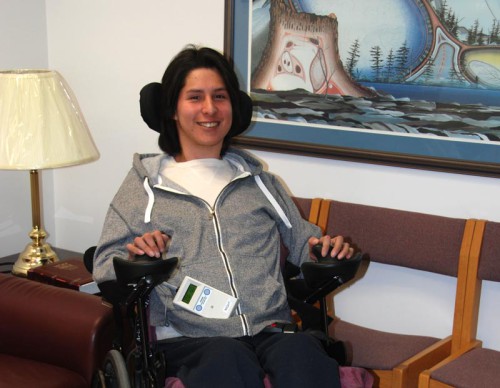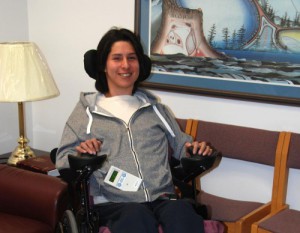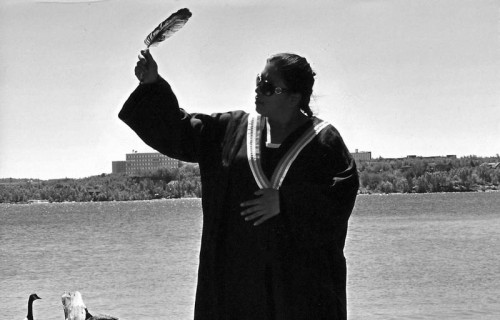LITTLE CURRENT—Gabe Abotossaway sits in one of the Manitoulin Health Centre’s visiting areas, eager to share his progress. He smiles a lot, his mouth spreading out in a grin over his cheeks made much fleshier since the last time this reporter saw the young man, and he looks healthy. His mother Beverly sits at his side, as always. She looks happy too, but weary, after almost a year of ups-and-downs with her eldest son, the year-to-date most definitely ending on a high note, home to Manitoulin.
It’s hard to believe that almost a year has passed since Gabe was involved in a head-on collision on Highway 69—an accident so bad the young man has been proclaimed lucky to be alive on more than one occasion and by more than one doctor.
The collision caused fractured limbs and ribs, a lacerated liver, a broken jaw, his spleen removed, as well as injury to his spinal cord.
It was at Health Sciences North in Sudbury, where Gabe’s healing process began, that he also made history, becoming the youngest patient to ever receive the new technology of a diaphragmatic pacemaker. In July of last year, Gabe underwent surgery to have a NeuRx Diaphragm Pacing System placed in his chest. This device ‘kickstarts’ his diaphragm into inflating and deflating, as doctors had discovered the right side of Gabe’s diaphragm had stopped working. The pacemaker also saw him off the ventilator.
After becoming comfortable with the pacemaker and having healed from his old wounds, Gabe was ready for the next step on his journey to recovery—rehabilitation. Gabe was flown to the Ottawa Hospital Rehabilitation Centre where he would begin a four-and-a-half month intensive rehabilitation program.
Thanks to his hard work, Gabe has made some significant improvements in his recovery.
Back at the MHC, Gabe moves his left arm up, as though going to give someone a high five, twisting his left hand inward. He and his mom joke that pretty soon he’ll have enough movement to give someone a slap.
“I can almost feel to the elbow,” he shares. “And I can feel my whole spine, all the way down.”
“I have dreams that I’m walking, not very good, but I’m still walking,” he adds.
Gabe says that days at the rehabilitation centre would begin at 7 am with personal care, breakfast, and a walk outside followed by appointments.
One of his appointments was for neuro psychology. “When I first had the accident, I couldn’t remember faces or names. Now I can remember the names of my nurses,” he smiles. “My short term memory is down, but I’m getting glimpses into the past two years. I still don’t remember the accident, just snippets.”
Gabe says he remembers looking down and seeing his body soaked in blood, the sounds of the jaws of life coming to rescue him from the car and the sight of the pick-up truck—the other vehicle involved in the collision.
He also saw a psychologist who taught him to get things off his chest and to be proactive in his care. Beverly shared how one day, the nurses who came in for his daily personal care just stared at him dumbly. They wanted Gabe to give them their directions. A task, at least at first, he found difficult to do.
“I’m good at being bossy now,” he grins. “I know everything about my body and its care.”
Gabe also saw an occupational therapist, teaching him the tools he will need for a life of his own. This includes a head operated mouse for a computer and a wheelchair operated by head movements too. The wheelchair he’ll soon have is equipped with three speeds and reverse. Beverly explains that he mastered it in 15 minutes. A testament, Gabe smiles, to video games.
“I’ll be on Facebook soon,” he promises, “and I’ll be able to Skype with people.”
Gabe also had appointments in respiratory therapy, including lung volume recruitment, or breath stacking. Gabe would be set up on a machine similar to a ventilator that allows his lungs to be expanded to near normal levels, thus reducing the risk of infection and pneumonia.
“It’s given him a whole lot of independence,” his mother says. “And not having to rely on mom all the time.”
Even chatting with Gabe is a step up. Months earlier a tracheostomy tube in his throat made that difficult, eating too. For some time, while in Sudbury, Gabe was fed through a feeding tube in his stomach and his weight was low. So low, in fact, that when he got to Ottawa the first order of business was weight gain and the hospital had him on double portions and high protein snacks until they were satisfied. He’s up to 130 pounds. Gabe was even able to satisfy a craving he’d had since being in the hospital—a McDonalds’ quarter pounder with cheese.
This craving is a testament to Gabe’s memory loss, as he was a vegetarian before the accident.
“You just can’t get over a quarter pounder with cheese,” he grins.
Perhaps the most exciting news Gabe has received is that plans are in the works for his own house in Aundeck Omni Kaning. It will be located near his late grandfather’s, Clayton Abotossaway, house on Highway 540, near the ball park. Construction may even begin as early as this fall, with Chris Perry of Perry and Perry Architects of Sudbury offering to do the design for the four-bedroom home.
The community has been readying for the young man’s return, with nurses from Mnaamodzawin being trained to care for Gabe, and even two personal support workers from Tunisia, who will live with Gabe full-time in his new home, are at the ready for that day. Derek Debassige of the Manitoulin Physio Centre in M’Chigeeng will also be Gabe’s physiotherapist. It was also important for the MHC to be the final stepping stone before Gabe returns to his family home, so staff could learn about his level of care and the diaphragmatic pacemaker, his mother shares.
“It feels great to be back on the Island,” Gabe says. “It feels like it’s been three years with my memory loss.”
He says he’s eager to see the new developments in his community, such as the skate park, the roofed rink, the walking trail and the new houses in Amelia Heights.
It was bittersweet to leave Ottawa and those that looked out and after him for almost five months, he admitted. “It was hard to leave, you get so accustomed to the nurses,” he says.
“I wish we could have brought them all home, right Gabe?” his mother asks. Gabe nods his head.
Gabe said he’s hoping for a good night’s sleep some day soon, as he’s gone without since his accident. This can be attributed to a number of things, Beverly explains, including depression, his pacemaker and other factors associated with the accident.
When asked about his future plans, Gabe says he’d like to relax for the summer, and then begin the process of studying, probably at Kenjgewin Teg Educational Institute. From there, perhaps a degree then on to teacher’s college. “I broke a lot of stuff, but my brain’s still here,” he smiles.
“You can do anything, even when bad things happened,” he encourages. “There’s rough patches in life, but you’ve got to keep going. Life is hard, but you’ve got to work through it.”
Peer support through the Canadian Paraplegic Association has been important in Gabe’s road to recovery and he hopes to become a mentor one day too, maybe even becoming a motivational speaker to students in schools.
“Since I’ve been through it, I can help others,” he says.
“I want to thank everyone who helped us and supported us along the way,” Beverly says. “The people here and those we just met who encouraged us and prayed for us.”
Gabe thanked everyone for the support and many kind messages. “It seemed like a lot of people cared,” he says.
He shared his idea for a wall of dedication in his new home—a wall that will list all those who did something nice for Gabe on his journey, so he can remember their kindness.
“Out of this tragedy, Gabe’s become an inspiration,” his mother says proudly. “He’s also a trailblazer with his pacemaker,” she adds, noting that the Canadian Paraplegic Association has already been in contact with Gabe about his pacemaker, asking him to be a spokesperson. Something he’s only willing to do.
“I want people to get out of the ICU (intensive care unit) and get home,” he says.
[polldaddy rating=”5515539″]





